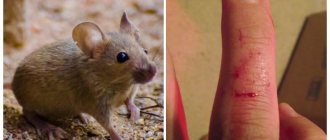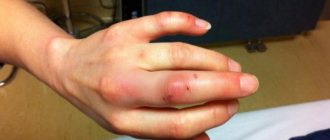The site provides reference information for informational purposes only. Diagnosis and treatment of diseases must be carried out under the supervision of a specialist. All drugs have contraindications. Consultation with a specialist is required!
First aid for animal bites: what is the danger of bites from cats, dogs, mice, raccoons, rats, foxes and other animals? What should you do if a person is bitten by an animal? What should you do to avoid becoming infected with rabies from an animal bite?
Both domestic and wild animals attack people quite often.
In most cases bites
come from dogs, cats, mice, rats, raccoons, hamsters, and foxes.
The danger of a bite from a particular animal is determined by several factors. Both the infectiousness of the animal and the depth of the bite, its size, as well as the effectiveness of first aid
that should be provided to the victim are taken into account. Bites from both wild and domestic animals are dangerous, first of all, because they can cause a person to become infected with rabies. In addition, such bites can provoke the appearance of an abscess, as well as infection of the wound. First aid for animal bites involves thoroughly washing the affected area with running water, applying a sterile bandage, and promptly consulting a doctor.
Bites from both cats and dogs, as well as from numerous wild animals, are considered quite dangerous to the human body. This is explained by the fact that in the mouths of animals there can be a huge number of microscopic organisms, which tend to cause the development of certain infectious pathologies. Bites from animals that suffer from rabies are especially dangerous. Rabies is an extremely serious viral pathology that very often causes human death. This fact forces us to take bites from not only wild but also domestic animals extremely seriously. In most cases, bites come from dogs, slightly less often people are bitten by cats. Bites from wild animals are extremely rare.
Why do you need a rabies vaccination?
Why was there a need to invent a vaccine for humans against rabies?
- It is impossible to predict how high the likelihood of contracting a dangerous disease is, but even today thousands of cases of infection are recorded annually.
- There is still no effective treatment for rabies.
- The virus lives on every continent, it can be found everywhere, which means absolutely anyone can get sick.
The vaccine against rabies was first obtained by the French microbiologist Louis Pasteur back in 1885. For a year, he worked on creating a prophylactic drug that would help cope with the developing disease. Thanks to his research, already in 1886 it was possible to save more than one thousand human lives.
Indications
Although the vaccine for humans against rabies was invented more than a century ago, even today it remains the only effective method of protecting and preventing this deadly disease.
Who needs to be vaccinated?
- Veterinarians are at risk for rabies.
- Anyone involved in catching and keeping stray animals.
- Laboratory workers who, due to the nature of their work, are exposed to infectious agents should be vaccinated.
- Vaccination is required for slaughterhouse workers.
- A preventive vaccination against rabies is indicated for a person if he is a hunter, forester, or taxidermist (makes stuffed animals from killed animals).
- Emergency prevention is carried out for anyone who has been bitten by an infected or suspicious animal.
- Vaccination is recommended for people traveling on vacation or business trips to countries where the risk of infection is increased.
Vaccination against rabies is indicated in the national calendar of preventive vaccinations for epidemic indications, since it is not used for everyone, but only for certain categories of citizens or in the event of an emergency.
Contraindications
According to the instructions for rabies vaccines, vaccination is prescribed to a person to prevent the disease and in emergency situations in case of an animal bite. These are well-known indications. But in what cases is it not done?
The rabies vaccine is the only one in the world that is administered to humans in any case, regardless of contraindications.
Despite the fact that its administration often causes adverse reactions.
Therefore, rabies vaccination is prescribed, including during pregnancy. At the same time, it is possible to save the life of the mother, and sometimes even the baby. After all, if infected, both will die.
A contraindication to routine rabies vaccination in humans is age - it is given starting from 16 years of age. But if a child is bitten by an infected animal, vaccination is carried out no matter what.
Vaccination schedule
Is the rabies vaccine dangerous for humans? - no, if you enter it correctly and in a timely manner. It is believed that if the vaccination is given later than 14 days from the moment of the bite, it is practically ineffective.
When active manifestations of the disease are already developing, there is no point in using it.
What are the rabies vaccination schedules for humans? They differ in the number of injections for routine and emergency immunization.
After infection, a person should wash the wound thoroughly with running water and soap before administering the drug. And only after that start prevention.
How is routine vaccination against rabies carried out?
- The first injection is given.
- The next one is prescribed on the seventh day.
- The last time they are vaccinated is on the 30th day.
- Revaccination is carried out after a year.
How long does the rabies vaccine last in humans? — with regular scheduled vaccination, the drugs protect for three years, so all subsequent injections of rabies serum are given at such intervals.
More recently, during the existence of the Soviet Union, the vaccine was unrefined; a person was injected at least 20 times in the abdominal area. Knowing all this, it was difficult to agree and complete the entire defense course. But at present, emergency prevention of rabies is carried out using more gentle methods, and the frequency of vaccination is much less.
In case of emergency immunization to treat an infected person, the vaccine is administered five times according to the following schedule:
- immediately after infection;
- on the third day after the first injection;
- on the seventh day;
- two weeks after the first injection;
- and on day 30.
This is a standard emergency human protection scheme. But sometimes, in order to consolidate the result, a sixth injection is given at the end of the third month after the first administration of the drug.
Where is a person vaccinated against rabies? Injection of medication for infection into the subcutaneous tissue is no longer prescribed; drugs are now used only intramuscularly. Adults and children over 16 years of age are advised to administer the vaccine into the deltoid muscle, that is, into the outer contour of the shoulder.
The rabies vaccine is administered to a child only in the hip area. Vaccination in the buttock is not allowed. The amount of drug administered in children does not differ from adults.
On average, 2 weeks after vaccination, the human body begins to produce protective cells against the virus.
Primary and secondary prevention
In order for the child to develop good immunity, the rabies vaccination is given 3 times. The second injection is usually prescribed a week after the first, and the third after 3-4 weeks. This type of prevention is called primary prevention and is performed to prevent the virus from occurring in the baby.
Vaccinating a child against rabies provides temporary protection against the virus, but if it is not there and the baby has been bitten, then it is advisable to find out whether the animal has this disease. Most often this cannot be done and you will have to undergo a course of injections. It consists of 1 injection of immunoglobulin and 6 injections of the COCAB vaccine, 5 of which must be given within 28 days, and the last within 90 days.
The body temperature most often does not rise after vaccination and it is better to start therapy no later than 1-2 days from the moment of the bite. Immediately after the incident, it is advisable to immediately treat the damaged area. To do this, you should superficially treat the wound with an antiseptic solution and inject immunoglobulin into it. This medicine is recommended to be injected into the surrounding tissues. The dosage is selected individually and is based on the person’s body weight. The remaining permissible amount of medicine should be injected intramuscularly away from the bite.
After vaccination, the injection of immunoglobulin should be made as far as possible from the site where COCAV was administered. This injection is performed only once and this is enough to synthesize antibodies in the blood. Over time, under the influence of the vaccine, the body itself will be able to produce them. Repeated administration of immunoglobulin is prohibited, since the second injection can disrupt the functioning of the produced antibodies and their synthesis.
Often, a standard drug administration scheme is used, namely at 0, 3, 7, 14, 28, 90. They must be carried out strictly on time and it is forbidden to drink alcohol during this period of time, so as not to reduce the effectiveness of the vaccine. It is permissible to interrupt the course of injections only if the animal that bitten turned out to be healthy. Such preventive measures are called secondary, that is, taken after a bite and without prior vaccination.
Side effects
What side effects can a person experience after receiving a rabies vaccine? This vaccination is quite well tolerated, but even here there are possible peculiarities that depend on the person’s immunity and on compliance with the rules for administering the medicine.
What complications or reactions can there be after a rabies vaccination in a person?
- Redness, swelling and soreness, as well as itching, often occur at the injection site.
- Common symptoms a person may experience after receiving a rabies vaccination include weakness, dizziness and headaches.
- Another possible reaction to the rabies vaccine is local enlargement of the lymph nodes.
- Some report nausea and abdominal pain.
- Sometimes minor pain appears in the muscle area.
- Unpleasant pain in the area where the vaccine was administered and a slight increase in temperature.
- Severe complications include an allergic reaction in the form of urticaria.
- The most unpleasant complications of the rabies vaccination are various disruptions in the functioning of the nervous system - sensory disturbances, weakening of the functioning of peripheral nerves and other changes that disappear a few weeks after vaccination.
What are the most common consequences of rabies vaccination in humans? These are local and general reactions from the body. Pain in the injection area, sometimes fever, headache and dizziness. The most dangerous consequences include an allergic reaction and disruption of the nervous system. Otherwise, the rabies vaccine is well tolerated.
Despite the considerable number of possible reactions and complications, not getting vaccinated is much more expensive, because human life is at stake.
List of prophylactic drug analogues and their cost
Treatment for rabies involves some burden on the human body, and accordingly, additional burden in the form of taking antibiotics and other medications is not advisable.
In addition, some medications may have a negative effect on the production of antibodies to the rabies virus, in particular:
- glucocorticosteroids;
- anti-malaria tablets;
- cytostatics;
- chemotherapy;
- radiation therapy;
- immunosuppressive treatment.
Thus, it is better to exclude a dangerous type of treatment and not use the listed drugs until the end of vaccination. You can take medications only in consultation with your doctor.
In addition to the negative consequences of taking rabies and other drugs together, complications can arise in some other cases.
Combination of some vaccines
As in the case of a tetanus shot, after such an injection you can swim and wet the injection site, but it is not advisable to comb it or rub it with a washcloth, as this can cause redness and swelling. In addition, a bath can also provoke an unpleasant reaction in the body, so it is better to refrain from such trips. If there are signs of an allergic reaction, you should inform your doctor.
Vaccination against rabies in humans is not recommended against the background of the use of immunosuppressive and radiation treatment, chemotherapy, the use of cytostatics, glucocorticosteroids, and antimalarial drugs. The listed groups of medications adversely affect the production of specific antibodies to the virus that causes rabies. Therefore, treatment should be suspended during vaccination.
There are drugs with similar composition among both domestic and imported vaccines.
Vaccine Kokav
The most popular are recognized (calculation per dose):
- Kokav (Russia). Price: 1720-2300 rub.;
- Rabipur. German drug. Price: 2700-3400 rub.;
- Indirab (India). Price: 7000-8000 rub.;
- Verorab (France). Price: 1100 rub.;
- Speeda (China) is not registered in Russia.
Anti-rabies assistance in our country is a free procedure.
Vaccines used
Where can a person be vaccinated against rabies? Normally, the vaccine should be available in any public medical institution - these are outpatient clinics, first aid posts (paramedic stations), hospitals and clinics. In the city, assistance to the injured person will be provided in the emergency room or in the surgical department. In rural areas, at least the first vaccine can be given at the nearest health center.
What rabies vaccines are there?
- Dry inactivated rabies vaccine.
- Russian "" is a culturally purified rabies vaccine.
- "", made in Germany.
- Indian "".
- “KAV” is also made in Russia, but compared to “Kokav” the dose is smaller, so it is used more often.
In addition to rabies vaccines, there are also immunoglobulins that come with them - human and equine.
Wound care
Bites are divided into two types, with different degrees of severity: superficial and lacerated. In the first case, the dog only bites through the skin and leaves puncture wounds without damaging the soft tissue. Bites require daily treatment with antimicrobial and anti-inflammatory medications to heal. Antibiotics may be prescribed at the discretion of the physician. As a rule, such wounds heal quickly. It is advisable not to wet the wound during healing.
A lacerated bite leaves deep injuries with bleeding. Such injuries are very dangerous. There is a possibility of damage to a large vein or artery. In this case, you must immediately go to the emergency room or call an ambulance. It is better to entrust the care of lacerated wounds to doctors.
Answers to frequently asked questions
The most common problems that vaccinated people face are the rules of human behavior after the administration of the drug. Let's find out what precautions need to be taken to ensure that the vaccine works and there are fewer complications, and also answer frequently asked questions.
You need to know that one of the important conditions for proper vaccination against an incurable disease is the absence of severe physical or emotional fatigue during this period. This means that during the entire course of immunization it is better to avoid sports and additional stress.
When it comes to rabies vaccination, no arguments for or against it should be decisive in the decision to do it or not. The infection is classified as particularly dangerous, so a conditionally infected person should not have the choice of whether to undergo vaccination. The drug is administered, even if there is an allergy to it, to all pregnant women and children, regardless of age. The most important thing in such a situation is to preserve human life.
This disease is caused by a virus that enters a person through the saliva of a sick animal. The most common way of transmitting rabies is a bite, after which vaccination is required, since the probability of developing the disease can range from 25 to 90%.
If an animal bites you, it is really necessary to call emergency doctors if:
- The animal's bite is minor, however, the person does not know whether the animal was vaccinated or not.
- A very deep bite, in which there is excessive damage to the skin, making it impossible to see the bottom of the wound.
- A man was bitten by an animal that produced a large amount of saliva from its mouth, and it attacked the person for no reason.
In such cases, the development of rabies is quite possible, so the victim should be urgently hospitalized. If the bite was inflicted by a dog or cat, then the victim should pay special attention to the further behavior of the animal, which will indicate the presence or absence of rabies. If rabies is the culprit, then a special course of therapy will be needed. And also, in order to detect the presence of rabies, you should observe the behavior of the animal, and not the victim, since in dogs and cats the incubation period in most cases is much shorter.
When are rabies vaccinations necessary for humans?
If a rabid animal bites a person, the saliva will definitely get into the wound, after which the disease will begin to develop. The incubation period of the disease is from 1 to 8 weeks, and even through the smallest wound the virus can enter the body. Frequent carriers are domestic cats, dogs, and rodents that have been bitten by a rabid animal and are carriers of the infectious disease. Immediately after the bite, the person is given an emergency vaccination. There are people who regularly undergo preventive scheduled vaccinations due to their professional activities:
- huntsmen;
- trainers;
- veterinarians.
What is the rabies vaccination?
In most cases, rabies injections are given to a person using two drugs: rabies vaccine and immunoglobulin. They have different operating principles, and their choice depends on the length of the incubation period of the virus. The doctor takes into account the extent and depth of the bites, their location and number. If they are mild, then one rabies vaccine is administered, since the person still has time before the virus begins to develop.
When the bites are severe, moderate, or more than 10 days have passed since infection, and there is no time to wait until your immunity appears, then a combined course is carried out - rabies immunoglobulin is also added to the vaccine. It immediately provides passive immunity for a short time, while the vaccine provides it only after 2-3 weeks, but for a long time.
Rabies vaccine
The rabies vaccine itself cannot kill the virus. Its task is to provide the human body with antigenic information about the infection immediately after a bite from an infected dog or other animal. Reading it, the immune system begins to produce antibodies and neutralizes the virus. Rabies vaccine for humans helps to acquire active immunity for a period of at least one year. The instructions say that rabies vaccination can be given after contact with a bitten or bitten animal, even several months later.
Anti-rabies immunoglobulin
Rabies vaccination with a vaccine begins to “work” only after 2 weeks. During this entire period, the body remains defenseless against infection, and to support it, temporary ready-made antibodies are introduced. Rabies immunoglobulin serum is a drug that contains concentrated antibodies obtained from donor blood. This may be a person or a horse that has been previously vaccinated. After administration, rabies immunoglobulin is completely eliminated from the body within several weeks, which is why such immunity is called passive immunity.
Timing of medication administration
You should always try to get your rabies vaccination on time, because it is the most important part of prevention. The disease occurs differently in animals and people, and the timing of drug administration, as well as the development of pathology, depends on the following nuances:
- The time from the moment the virus enters the body until the first signs appear is usually from 10-14 days to a year. That is why rabies vaccination should be performed if there is even minimal suspicion. After all, people, having forgotten about the incident and not seeing any signs in the first weeks, think that it has passed, but the disease can develop a little later. You can reduce the probability to virtually zero with the help of 3 doses of the vaccine and 1 immunoglobulin, and for complete protection it is recommended to complete the entire course;
- The virus is not transmitted from person to another person. However, there have been cases where rabies was transmitted along with a transplanted organ. This is possible while the disease is in the incubation period;
- It injects mainly into children, because they play with animals more often than others. Sometimes it is not possible to save children because they are afraid to talk about the bite, especially because of the stories that they need to take 40 injections against this virus.
Timely vaccination against rabies helps the body synthesize antibodies. They block the entry of the virus into the nerve fibers, which prevents it from entering the CNS (central nervous system) and causing acute encephalitis. It is from this that patients most often die.
The incubation phase of the disease lasts a certain period of time, which depends on the location of the bite. The fastest developing virus is one that enters the body through the upper part of the body (from the torso and above). Rabies manifests itself much more slowly if the lower half (below the torso) was bitten.
The host of the virus is most often wild animals (wolves, foxes, etc.) and it is they who most often infect people. In second place are stray dogs. If a pet has bitten, then in such a situation they usually do not give rabies injections. After all, such animals undergo annual vaccination and it is enough to observe them for 10 days.
How is vaccination against rabies administered to humans?
The vaccination schedule in all countries of the world is based on WHO requirements, but sometimes it may differ due to the prevalence of the virus in each specific region. Injections in the stomach have not been given for 40 years. For adults, the vaccine is administered in the upper arm, and for children, in the front of the thigh. Under no circumstances should serum be injected into the gluteal muscle.
Modern rabies vaccination consists of 6 injections of rabies vaccine on days 0, 3, 7, 14, 30 and 90 from treatment. The schedule and dose of drugs for a child and an adult are no different. Rabies immunoglobulin is administered once before the vaccine in the following cases:
- when the patient presents late (more than 10 days after the bite of a suspicious animal);
- for severe and moderate bites.
How much does it cost: price in pharmacies
Rabies vaccine (5 ampoules of 1.0 ml each) can be purchased at the pharmacy for 2220-2300 rubles/pack. Dispensed by prescription. The cost of the procedure in a paid clinic will be 1000-1100 rubles.
You can get vaccinated either at a local clinic or at any paid clinic. How much should a standard vaccination cost?
The average price is 900 rubles. However, in different regions, the management of a particular clinic may set a different price. From 800 to 1400 rubles per injection.
Thus, the patient may need from 4500 to 7400 rubles for the entire course. The cost is not small, but life is more expensive.
So, vaccination should be carried out in a specialized institution. Do not neglect visiting the clinic if you suspect a possible infection. Take care of your health.
Contraindications
According to the instructions, vaccinations to prevent rabies are not recommended for children who have a weakened immune system, women during pregnancy, and people with exacerbations of chronic diseases. The rabies vaccine is administered with caution to patients suffering from AIDS, oncology, or who are intolerant to some of the components of the product. After being bitten by a rabid dog or other animal, vaccination is mandatory, since failure can cause the death of a person.
First aid
Immediate visit to the emergency room is the first step to take after a dog attack. The doctor will tell you what vaccinations are given for a dog bite when examining the patient.
First aid includes:
- compression of the wound for enhanced bloodletting - with the release of blood, dangerous bacteria and viruses are removed;
- washing the wound with running water to eliminate the animal’s toxic saliva as much as possible;
- lathering the bite site with laundry soap - the alkali included in the composition perfectly fights infections acquired during contact with the animal;
- treatment of the wound, areas of the outskirts with an antiseptic - use hydrogen peroxide 3%, solutions "Furacilin", "Chlorhexidine", "Miramistin";
- applying an ointment with antibacterial properties to the affected area - “Baneocin”, “Gentaxan”, “Betaine”. If the wound is large and requires suturing, then ointment is not applied;
- applying a sterile napkin and loosely bandaging the wound;
- applying cold in the form of ice wrapped in thick cloth.
The mandatory dog bite vaccine includes anti-tetanus serum, an anti-rabies drug.
Side effects
The administration of the drug is sometimes accompanied by local or general reactions. In the most serious cases, Guillain-Barré syndrome develops, which is accompanied by autonomic disorders and other complications. Anti-rabies injections are not compatible with alcohol, so taking it is prohibited throughout the course. Common side effects.
You won't surprise anyone with a stray dog in the city. Especially in the spring, when it’s time for a “dog wedding.” Despite the fact that utility workers organize the capture of animals, many run away and hide.
In addition, some of them are quite aggressive, and on occasion they can bite an adult or even a child. It is not a fact that the animal will be rabid, but in order to be sure of this, it needs to be observed for some time. And this is not always possible.
Therefore, to prevent such a dangerous and fatal disease without treatment as rabies, it is necessary to undergo a course of rabies vaccine. Where are rabies injections given? After all, just a decade ago they scared children, don’t touch the dog, they will give you 40 injections in the stomach! But what is the situation now?
Rabies
To become infected with this disease, the virus must enter the bloodstream from a sick animal. As a rule, this occurs through a bite, since infected animals are not particularly friendly. Almost any animal, both domestic and wild, can get sick. These are cats, dogs, wolves, basement rats, and even bats. So infected foxes begin to come out of the forest towards people and come quite close, which is not typical for a wild animal.
Therefore, with bites and a fearful question about where rabies injections are given, people who, due to their professional duties, often communicate with animals, most often turn to the doctor. These are rangers, veterinarians, trainers, hunters, slaughterhouse workers and those who catch stray animals, as well as residents of villages and towns located near the forest.
After a bite and penetration of the virus into the blood, the disease does not manifest itself immediately. The incubation period lasts for 1–8 weeks.
The closer the bite is to the face and to the center of the body, the faster rabies develops. Deep and ragged bites are also dangerous. A small bite or salivation of a wound on the extremities is more favorable for the prognosis.
By the way, the majority of those bitten become infected with the virus (from 20 to 90%), but not all.
What to do if you are bitten?
1. Wash the wound under running water and soap.
3. If the wound is severe, then you need to call an ambulance so that, in addition to the rabies vaccine, painkillers are administered, the bite is treated and an antiseptic bandage is applied.
4. If a pet is bitten, it is quarantined and observed. No walks or contact with other people or animals, only feeding. Over the next 10 days, a sick animal will begin to show aggressiveness, fear of hydrophobia, and then die.
Some sources advise not to inject until the animal is dead. But his illness can last for 10 days, and the incubation period in some cases lasts a week, and the vaccine is effective even before the first signs of rabies appear. If they appear before treatment, the prognosis worsens significantly.
Where are rabies injections given?
Over the past decade, science has come a long way, and 40 injections in the stomach are no longer necessary. Six injections are enough to be sure that the virus is defeated.
The first injection is given immediately after the patient’s initial visit. The second - on the 3rd day, the third - on the 7th, the fourth - on the 14th, the fifth - on the 30th, the last - on the 90th. Where are rabies injections given? Nowadays they are no longer given in the stomach; the injection is intramuscular; it can be done in the buttock or in the deltoid muscle of the shoulder.
The number of injections depends on how dangerous the bite is. If it is small, located far from the face and body, and it is also possible to observe a sick animal, then perhaps the doctor will limit himself to prescribing three injections. In other conditions, all 6 injections are indicated.
Vaccination helps the body produce antibodies against the rabies virus. In parallel with this, during the first three days, ready-made anti-rabies immunoglobulin is additionally administered.
When indicated, everyone is vaccinated, even pregnant women. Alcohol consumption is prohibited during the rabies vaccine injection.
When does a vaccine not help?
There are cases when emergency preventive measures do not produce results. This.
Rabies is one of the most dangerous diseases. It is caused by a virus that passes to a person from the bite of an infected animal. The disease affects the nervous system and is characterized by death. To prevent the disease, it is necessary to get vaccinated: a rabies injection.
By nature it belongs to the genus Lyssavirus and the family of microviruses Rhabdoviridae. The causative agent of the disease can be detected in saliva, secretions and tears. The virus is destroyed at a temperature of 56°C within 15 minutes, and at 100°C in 2 minutes; it does not tolerate sunlight and ultraviolet rays, ethanol and disinfectants. At the same time, the rabies pathogen is extremely resistant to low temperatures, antibiotics and phenol. The disease can be transmitted to humans by wild and domestic animals. Foxes and stray dogs are especially dangerous in spring and summer. The animal is contagious 3-10 days before the onset of symptoms and throughout the entire duration of the disease. Characteristic signs of a sick animal may be salivation, lacrimation, and hydrophobia. A person can become infected when bitten or by contact with saliva of a large animal on damaged skin and mucous membranes. There are also cases of infection by airborne droplets, through water and the placenta. If the rabies injection is not given on time, the virus begins to become active.
When the virus enters the body, it quickly spreads along the nerve endings and in a short time affects the entire nervous system, causing swelling, hemorrhage and serious changes in the brain. can last from 30 to 50 days, and in some cases 10-90 days and up to a year.
The disease occurs in three stages. The first stage is characterized by general malaise, muscle pain, a slight increase in body temperature, burning and pain at the site of the bite, depression, insomnia, and hallucinations. Stage II occurs after one to three days - agitation, fear of hydrophobia, noisy breathing, convulsions, aggression, sweating and salivation begin. After two or three days, the disease enters the final stage, when calmness sets in and hydrophobia goes away. Temporary relief ends with an increase in temperature to 42 degrees, then paralysis, convulsions, and death occur. The entire illness lasts about 7 days.
Disease treatment and immunization
The disease is practically incurable. At the same time, it can be prevented. In this case, it is necessary to give an anti-rabies injection no later than two weeks after the animal bite. In this case, a specific immunoglobulin is administered or active immunization is carried out - vaccination against rabies.
Usually they follow this scheme: the rabies injection is given on the first, third, fourteenth and twenty-eighth days after the bite. It is also recommended to get another injection ninety days after the first vaccine administration.
The injection is best given in the thigh or shoulder. If a person has been bitten, but was previously vaccinated, there are enough antibodies in his body, and he is vaccinated without immunoglobulin.
Persons who frequently interact with animals, for example, veterinarians, hunters, need to get a preventive vaccination, with revaccination after one year, and subsequently every five years.
How to behave if a person has been bitten by an animal
After a bite, wash the bite area thoroughly with soap and water. Then you should consult a doctor, providing all available information about the biting animal and the circumstances of the bite. If the doctor cannot verify that the animal does not have rabies, then it is necessary to take the course of vaccinations that he prescribes.
If the bitten person is in a serious condition, he may require hospital treatment, especially for people with diseases of the nervous system, allergy sufferers, pregnant women and those who have been vaccinated against other diseases within the last 2 months. During the vaccination itself and subsequently for another six months, you should avoid drinking alcohol, and you should also not be overtired, hypothermic or overheated.
If after administration of the vaccine the condition worsens and side effects occur, you should contact medical personnel and temporarily stop vaccinations. The decision to continue vaccination is made by a physician after the conclusion of a neurologist, radiologist and therapist.
A dog is man's friend. A furry pet can become a real comrade, companion and protector. Despite this fact, hundreds of men and women are attacked by street dogs every day.
Sharp fangs are only a small part of the problem; when bitten, a dangerous virus can enter the human body. Injections after a dog bite are almost a mandatory procedure, because a timely administered vaccine can save your life.
Dangerous consequences of a dog bite
Why is a dog bite dangerous?
There can be several negative consequences. Sharp fangs of animals pierced into human flesh will inevitably provoke bleeding. In this case, the vein and artery may be damaged.
In the most difficult situations, heavy bleeding will begin. Not all bites end so badly. Most likely, the dog will only touch the skin. In this case, no need to worry!
In just a few days you will fully recover and the damaged area of the body will heal. Lacerated wounds, on the contrary, are considered more dangerous. Both muscles and bones can be damaged.
Any person is not immune from. A dog can suddenly attack even on the street. Along with saliva, various microorganisms will enter the wound and cause inflammation.
In some cases, a person may be diagnosed with tetanus. The infectious agent can enter the wound along with the soil. Thus, doctors recommend administering a special vaccine to the victim.
An attack by a wild dog in some cases will cause irreparable psychological consequences. Young children and people with heart disease should definitely receive urgent medical care.
There is a high risk of developing not only a number of mental disorders, but also heart failure.
Remember that dogs are not the only source of rabies. Foxes, wolves, beavers, ferrets, squirrels and even bears can infect any person. The only time you don't need a vaccination is if you've been bitten by a small rodent or bird.
You need to remember that:
1.
Cat bites in most cases provoke the development of a local infection. Most likely, this happens because the bites of these pets do not particularly alarm people. In addition, there is an accumulation of numerous microbes in the cat’s oral cavity. Infection from such bites occurs in approximately fifty percent of cases.
2.
Bites in the area of the lower and upper extremities, as well as the palms, become infected especially often, and all because these areas of the body are almost constantly in contact not only with microbes, but also with dirty surfaces. Bites on the face are also very easy to become infected.
3.
In the case of simple wounds, infection is more frequent, since with deep lesions people most often consult with specialists, but minor wounds do not particularly bother them.
4.
Domestic animals are much less likely to carry rabies than wild animals.
5.
Rat bites are considered especially dangerous for humans, since these animals are very often infected
with spirochetes
, which tend to provoke the development of fever in the human body, accompanied by an excessive increase in body temperature and the occurrence of numerous acute symptoms.
6.
Almost all wounds from animal bites have uneven edges, and damage to both blood vessels and muscles, as well as tendons, is possible.
7.
Almost always such wounds contain animal saliva.
Signs of rabies in humans
Rabies -
This is one of the most dangerous disorders that a person can contract from a dog. The disease in some cases causes death.
Sometimes the animal does not show any signs of illness at all, since foam at the mouth does not appear immediately.
Men and women can become infected through any contact with a dog. Simply touching the infected saliva to the mucous membrane of the eyes, mouth or nose will be enough. The virus spreads throughout the body slowly, and it has a negative effect on the nervous system.
A rabid dog has several external signs that you should be wary of. Animals become more aggressive and irritable. Any touch or sharp sound may bother him. A lot of drool accumulates near the mouth of sick dogs.
The signs of rabies in humans are slightly different than in pets. They appear only a week after contact with an infected dog. A bite from a sick animal is not a one hundred percent guarantee of the development of the disease. It all depends on the area of damage, the strength of the immune system, as well as some minor factors.
Injuries in the facial area are especially dangerous. The length of the incubation period varies depending on the individual characteristics of the organism. The person becomes more aggressive, he feels constant dry mouth.
After some time, the first convulsions and hallucinations appear. Patients are characterized by increased sensitivity of the organs of hearing and vision. People are diagnosed with a fear of water, and frequent spasms are observed in the throat muscles. Consciousness suffers, and paralysis may occur.
Death occurs within a week after the first signs of the disease form. Most often a person dies from suffocation. Rabies is a fatal disease; recovery after the end of the incubation period is almost impossible.
People who have been bitten by an unknown dog on the street should consult a doctor and get vaccinated.
Rabies vaccination
Rabies injections are prescribed to a person immediately after being bitten by a stray dog. This way you can avoid the most dangerous virus. The injection must be given by a radiobiologist. It is possible to find the right office in a district clinic, as well as in a special medical center.
There is a special schedule for administering the vaccine.
How many injections do doctors give to a patient who has been bitten by a dog?
The first dose of the drug should be administered as early as possible, preferably on the day of contact with the dog. In parallel with the vaccine, rabies immunoglobulin is injected into the human body.
Immediately after a dog bite, provide first aid to the victim. Then contact a traumatologist. It is important that not much time has passed since the incident. 2 weeks is the deadline for vaccination to have a positive effect. It is not necessary to administer the entire course of drugs. If the animal turns out to be healthy, you can stop the treatment process.
If you've been bitten by your own dog and are up to date on their rabies vaccinations (which are limited to one year), you don't have to worry. In other cases, your pet will be quarantined for ten days.
If the incident occurred on the street, then special service workers must catch the dog and send it for laboratory examination. Once doctors are satisfied that your dog is completely healthy, you can stop taking rabies vaccinations.
Risk group
Vaccination against rabies for a person after a dog bite is vital:
- if the saliva of an infected animal comes into contact with damaged skin;
- in case of death of the dog 5-7 days after the bite;
- when the dog comes into contact with wild animals;
- if injuries were caused by stray dogs.
The risk group consists of people whose professions include work and contact with various animals, including dogs - veterinarians, foresters, specialists in catching stray dogs. This category of patients often turns to doctors with questions: how many injections are given for a dog bite, is it necessary to give injections after a dog bite.
The bitten person is not vaccinated if the animal has been vaccinated against rabies; observations of the dog did not reveal any abnormalities in the health of the four-legged pet 10 days after the bite.
Common Side Effects
This vaccine may cause side effects. Some patients experience pain and itching in the injection area. Also, redness and swelling often appear on the body. The next day there is heaviness in the abdomen and muscle pain. Very often, patients experience dizziness.
The administration of globulin will also introduce some unintended consequences. The heart rate increases, headaches and even nausea appear. The voice becomes hoarse, and the person feels general weakness of the body for several days.
The vaccine has no special contraindications. Thus, this is a universal way to protect your body from rabies.
First actions after a bite
The victim should be given first aid immediately after contact with a sick animal. First of all, it is necessary to examine the wound; in case of serious and deep injuries, immediately call an ambulance. If the bones, ligaments and blood vessels are intact, then you can do it yourself.
Follow the exact algorithm of actions:
- Stop the bleeding quickly. To do this, apply a tourniquet to the body above the wounded area (if an artery is affected) or a regular bandage.
- Wash the wound with peroxide. After some time, it is necessary to apply iodine or brilliant green to the damaged area.
In some cases, such assistance will be sufficient. In all other situations, you should go to see a traumatologist. Deep puncture or laceration wounds are the most dangerous.
The bite site will need to be examined daily and the bandage changed regularly. Do not forget that an animal that has bitten a person may have rabies; do not forget to undergo the vaccination procedure.
Summarize
Rabies -
This is a very serious illness, which in some cases causes the death of a person. Men and women should try to avoid stray dogs, especially if they are aggressive.
There are a large number of dangerous consequences of bites. If you are attacked by an animal on the street, you should immediately consult a doctor. You can tell if your dog has rabies by some external signs. If an animal behaves strangely, then stay away from it.
People who are bitten most often are those who do not avoid contact with street dogs. Try not to disturb the dog when it is near the puppies, eating or sleeping. It is also not advisable to leave a small child alone with an animal.
If you are nevertheless bitten by an unfamiliar dog, you will need to see a doctor. Several injections can save a person’s life, take care of your health!
Owners' responsibility for animals
Each owner is responsible for his pet. Proper and constant care is important for pets. The animal must be vaccinated. If an animal bites, the owner may be sued for compensation for material and moral damage.
The owner is also subject to the following sanctions:
- Fine. The amount of the fine is determined by the court
- Arrest up to 6 months
- Compulsory or corrective labor
- Restriction of freedom up to 3 years
The animal is subject to a medical examination and if rabies is detected, the animal is killed.
Animals should be handled with care; there is no need to tease or provoke them. In case of a bite, even a shallow one, you need to seek help from a medical facility.










